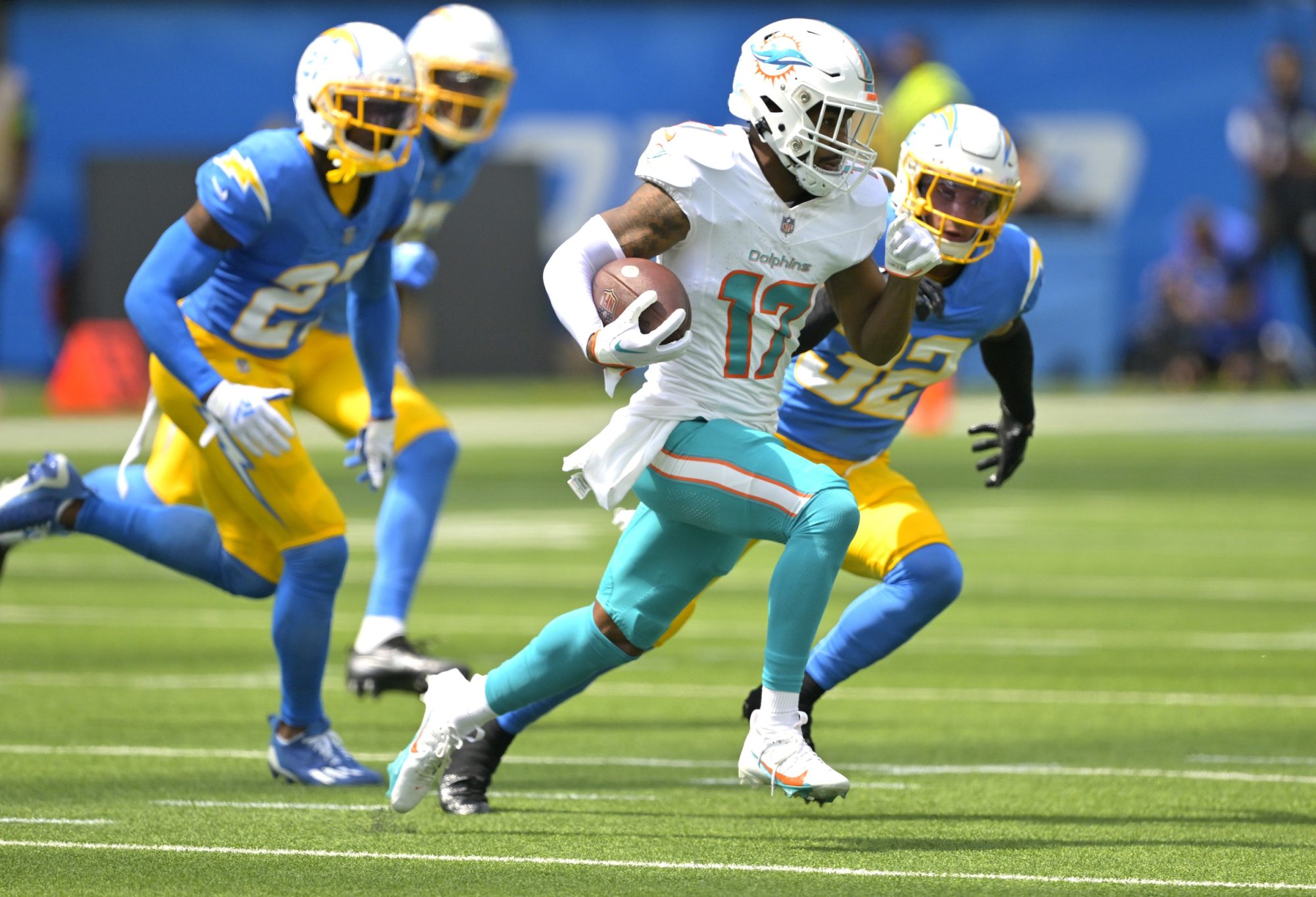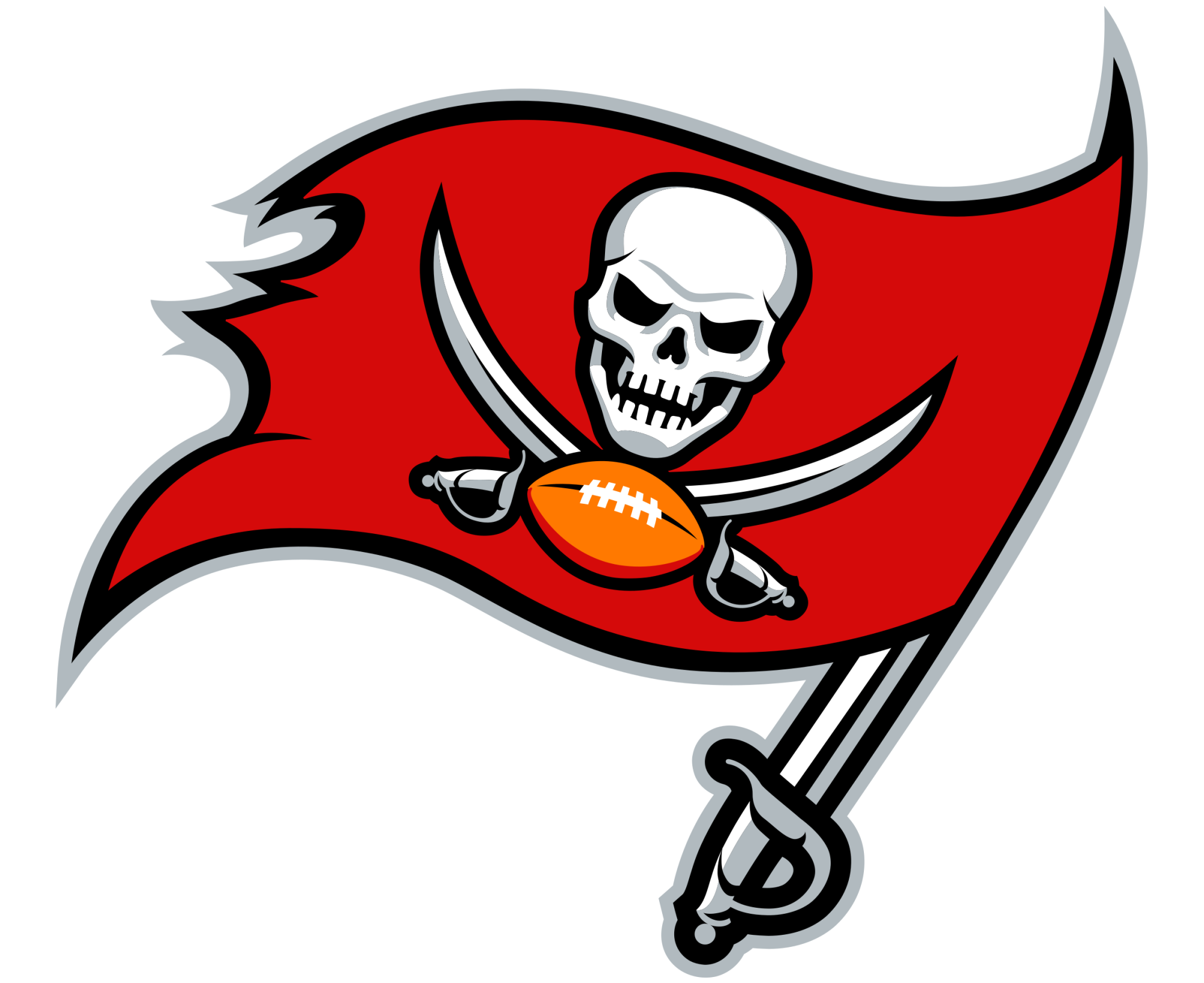On Jaylen Waddle and the Idea Of Two High-Priced Wide Receivers

Sep 10, 2023; Inglewood, California, USA; Miami Dolphins wide receiver Jaylen Waddle (17) is chased down by Los Angeles Chargers cornerback J.C. Jackson (27) and safety Alohi Gilman (32) after a pass play in the first half at SoFi Stadium. Mandatory Credit: Jayne Kamin-Oncea-USA TODAY Sports
It’s still early to think about the future at wide receiver for the Miami Dolphins, but teams generally plan for their salary cap outlook three years in advance. Philosophically speaking, the team management has already budgeted for what to do and who to extend. With a team-building perspective in mind, is it possible, realistic —and positive — to have two high-end wide receivers with top of the market contracts? That’s a reality general manager Chris Grier is going to face in the next two offseasons.
Tyreek Hill is currently the highest-paid offensive non-quarterback in football, earning $ 30 million per season. He’s under contract through 2026, so his situation is mainly solved — even though his cap hit jumps from $ 12.8 million in 2023 to $ 31 million in 2024, it’s hard to imagine the Dolphins parting ways with him anytime soon, and a restructure is the likely scenario next year.
The bigger question is what the Dolphins are going to do with rising star Jaylen Waddle.
As a third-year player, Waddle will become eligible for an extension next offseason. However, he has a fifth-year option available for 2025, so he will still have two years of control for Miami.
It’s unusual for teams to pay two top wide receivers at the same time. But this has been a more common trend around the league, considering the new general perception of value over the position.
The highest-paid WR2 is Los Angeles Chargers’ Mike Williams, at $20 million per year, right below Keenan Allen, at $20.025 million. The other top duos in terms of yearly average are Chris Godwin ($20 million) and Mike Evans ($16.5 million) from the Tampa Bay Buccaneers; DK Metcalf ($24 million) and Tyler Lockett ($17.25 million) from the Seattle Seahawks; and Davante Adams ($28 million) and Hunter Renfrow ($16.16 million) from the Las Vegas Raiders. Except for the Raiders, all teams have reached the playoffs since paying both players. It’s important to emphasize, though, that Godwin was still under his rookie contract when the Buccaneers won the Super Bowl in 2020.
There are four possible paths to choose from, and this decision will inform how Grier sees the long-term situation of the offense.
Early Extension
Generally, it’s the best long-term option if the team has decided to keep the player. The longer management waits, the more expensive the contract becomes. Other players from the same position sign extensions, and the market goes up from year to year because of annual salary cap increases. So it’s relatively surprising that the star receivers from the 2020 class, Justin Jefferson and CeeDee Lamb, haven’t reached extensions with their teams — Minnesota Vikings and Dallas Cowboys, respectively.
They are probably asking for the moon, and rightfully so. The teams want to wait because they still have two years of control over the players considering the fifth-year option. And, besides that, there is a fair drawback for the team: It assumes the risk of a career-altering injury.
However, nowadays those types of injuries are pretty rare. If the team really believes they want to keep the player for the long-term, it makes sense to guarantee a deal as soon as possible.
If the Dolphins can extend Waddle before Jefferson, Lamb, and other players from the 2021 class (Ja’Marr Chase, DeVonta Smith), they will probably achieve a cheaper deal.
Not-So-Early Extension
There aren’t many recent parameters for this, but most teams have extended their talented young wide receivers one year before they hit free agency (Deebo Samuel, DK Metcalf, Terry McLaurin). But all of them were later picks, so teams didn’t have their fifth-year options as the Dolphins have for Waddle. That means all of them re-signed in the first year of extension eligibility. From 2019, Hollywood Brown was the closest example. However, he was traded from the Baltimore Ravens to the Arizona Cardinals, who picked up his option and let his contract expire.
If the Dolphins want to extend Waddle just one year before he is a free agent, it will happen before the 2025 season, before his fifth-year option kicks in. That would probably be more expensive, but it could still be a savvy decision. Miami would have a clearer picture of the wide receiver market and one less year to risk a severe year with a player under an expensive deal.
Moreover, they would keep a low cap hit in 2024 and lower his 2025 number when the extension gets done. Being a three-, four- or five-year extension, the Dolphins would have the ability to keep Waddle for a longer time too. Considering a likely backloaded contract, the deal would allow the Dolphins to manage more easily the two high-paid receivers.
Hardball
There’s a scenario where the Dolphins can do what the Cincinnati Bengals are doing with Tee Higgins, a second-round pick from 2020. As the Bengals don’t have a fifth-year option, the secondary weapon is already in a contract year. The sides talked extensively about a new deal during the offseason, but couldn’t find a common ground. So there’s a scenario where the Bengals are forced to franchise tag Higgins, which is extremely impactful because the entire value hits the cap at the same time, tag-and-trade him, or simply losing him in free agency (the unlikeliest scenario).
This is a similar situation in the sense that Higgins is the second receiver of the team, as Waddle is for the Dolphins. However, the Bengals’ top receiver, Chase, is also young — actually, younger than Higgins. Hill is older, and there’s a real chance that Waddle becomes the top receiver throughout his second contract.
If the Dolphins want to play hard ball, though, they can realistically exercise the fifth-year option and apply two consecutive franchise tags on Waddle, keeping him through 2027. In 2028, a third franchise tag would mean 140% of the previous salary, making it virtually impossible to execute.
Trade
The Tennessee Titans didn’t want to pay A.J. Brown, so they decided to trade him. The situation is not exactly the same because Brown was by far the best receiving weapon on the Titans’ roster, but the decision was so bad that general manager Jon Robinson got fired months later. The Dolphins still have Hill and an offensive head coach, so there’s a scenario where Grier understands it makes little sense paying two top receivers and letting other areas of the team be uncovered. In this case, and considering Waddle’s production, age, and skill set, the Dolphins would most likely receive at least what the Titans got for Brown — a first- and a third-round pick.
Taking into consideration how important Waddle is for Tua Tagovailoa, how well he complements Hill, and the increased value of the wide receiver position to win games, extending Waddle is the likeliest and ideal scenario for the Dolphins. They will probably try to do this next offseason, but the market reality could dictate a challenging negotiation. The most usual path is to exercise the fifth-year option and extend Waddle before the 2025 season, and this would be a smart approach analyzing the Dolphins long-term roster construction outlook.
Up Next





